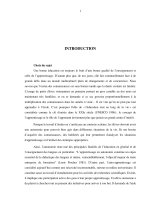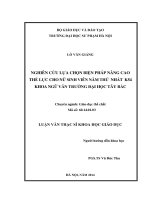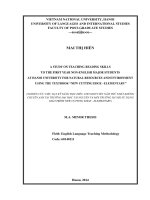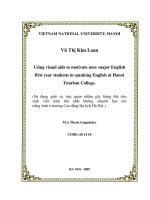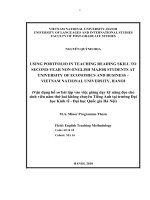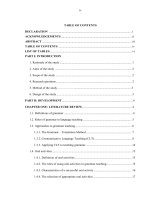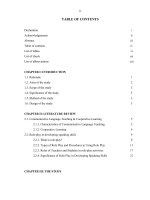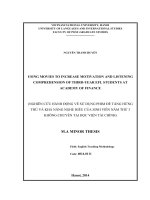Nghiên cứu thăm dò về chiến lược học từ vựng về chiến lược học từ vựng của sinh viên năm thứ nhất không chuyên tiếng anh trường đại học tân trào
Bạn đang xem bản rút gọn của tài liệu. Xem và tải ngay bản đầy đủ của tài liệu tại đây (811.47 KB, 63 trang )
VIETNAM NATIONAL UNIVERSITY, HANOI
UNIVERSITY OF LANGUAGES AND INTERNATIONAL STUDIES
FACULTY OF POST- GRADUATE STUDIES
---------------*******--------------
PHẠM THỤC ANH
AN EXPLORATORY STUDY ON VOCABULARY
LEARNING STRATEGIES BY FIRST YEAR NON-ENGLISH
MAJOR STUDENTS AT TÂN TRÀO UNIVERSITY
(NGHIIÊN CỨU THĂM DÒ CHIẾN LƯỢC HỌC TỪ VỰNG
CỦA SINH VIÊN KHÔNG CHUYÊN TIẾNG ANH NĂM THỨ NHẤT
TRƯỜNG ĐẠI HỌC TÂN TRÀO )
M.A. MINOR PROGRAMME THESIS
Field: English Teaching Methodology
Code: 6014.0111
HANOI, 2014
VIETNAM NATIONAL UNIVERSITY, HANOI
UNIVERSITY OF LANGUAGES AND INTERNATIONAL STUDIES
FACULTY OF POST- GRADUATE STUDIES
---------------*******--------------
PHẠM THỤC ANH
AN EXPLORATORY STUDY ON VOCABULARY
STRATEGIES BY FIRST YEAR NON-ENGLISH MAJOR
STUDENTS AT TÂN TRÀO UNIVERSITY
(NGHIIÊN CỨU THĂM DÒ CHIẾN LƯỢC HỌC TỪ VỰNG
CỦA SINH VIÊN KHÔNG CHUYÊN TIẾNG ANH NĂM THỨ NHẤT
TRƯỜNG ĐẠI HỌC TÂN TRÀO )
M.A. MINOR PROGRAMME THESIS
Field: English Teaching Methodology
Code: 6014.0111
Supervisor: Lê Văn Canh, Ph.D
HANOI, 2014
DECLARATION
I, Pạm Thục Anh, hereby certify that the thesis entitled “An exploratory study
on vocabulary strategies by first year non-English major at Tân Trào University” is
submitted for the partial fulfillment of the Degree of Master of Arts at the Faculty of
Post Graduate Studies - University of Languages and International Studies- Vietnam
National University, Hanoi. I also declare that this thesis is my own work and effort
and that it has not been submitted anywhere for any award where all other sources of
information have been used, they have been acknowledged.
Ha Noi, 2014
Signature
Phạm Thục Anh
i
ACKNOWLEDGEMENTS
To fulfill this minor thesis, I have been indebted to many people, so I would
like to express my sincere thanks to all of them for their valuable contributions.
First of all, I would like to express my deepest gratitude to my supervisor
Ph.D Le Van Canh who supervised, advised and supported me throughout the
realization of this thesis. Without her endless assistance, precious advice and detailed
comments my work would not have been completed.
Furthermore, I want to owe special thanks to all the lecturers at the Faculty of
Post Graduate Studies- University of Languages and International Studies - Vietnam
National University, Hanoi for their useful and interesting lectures, which have
inspired me to go on this paper.
In particular, I send my thanks to my husband who supported and encouraged
me while the work was in progress.
Last but not least, my heartfelt thanks go to my family, my friends and my
colleagues for their helpful support and continuous encouragements.
ii
ABSTRACT
This paper reports on vocabulary learning strategies by first year non-English
major students (N=219) at Tân Trào University. The purpose of the study is to
explore (1) the most commonly-used vocabulary learning strategies that the first year
non-English major students at Tân Trào University were using to learn English
vocabulary, (2) reasons for their preferences and (3) the effectiveness of those
strategies to their vocabulary learning which is self-evaluated by the students. A
vocabulary learning questionnaire and interview were used for data collection. The
study points out that (1) learners only limite to some strategies, (2) there is a strong
influence of teaching method and past learning experiences on learners‟ choice of
vocabulary learning strategies, and the practice of these limited vocabulary learning
strategies helps learners to retain sound, spelling and equivalent meaning of a word,
and (3) learners realize the benefits of those strategies on retaining sound, spelling
and equivalent meaning of a word and help them concentrate on lessons.
iii
LISTS OF TABLES
Page
Table 1: Vocabulary learning strategies in the questionnaire
18
Table 2:Overall mean score of vocabulary learning strategies used by the
26
students
Table 3: Reasons for preferred vocabulary learning strategies
28
LISTS OF FIGURES
Page
Figure 1: Students‟ use of DET strategies in vocabulary learning
21
Figure 2: Students‟ use of SOC strategies in vocabulary learning
22
Figure 3 : Students‟ use of MEM strategies in vocabulary learning
23
Figure 4 : Students‟ use of COG strategies in vocabulary learning
24
Figure 5: Students‟ use of DET strategies in vocabulary learning
25
iv
TABLE OF CONTENTS
DECLARATION ...........................................................................................................i
ACKNOWLEDGEMENTS ......................................................................................... ii
ABSTRACT ................................................................................................................ iii
LISTS OF TABLES .....................................................................................................iv
LISTS OF FIGURES ...................................................................................................iv
TABLE OF CONTENTS ..............................................................................................v
PART A: INTRODUCTION .....................................................................................1
1. Rationale of the study............................................................................................1
2. Aims of the study ..................................................................................................2
3. Objectives of the study ..........................................................................................2
4. Research questions ................................................................................................2
5. Scope of the study .................................................................................................3
6. Method of the study ..............................................................................................3
7. Design of the study................................................................................................3
PART B: DEVELOPMENT ......................................................................................4
CHAPTER 1: THEORETICAL BACKGROUND .................................................4
1.1 Introduction .......................................................................................................4
1.2 An overview of learning strategies research ...................................................4
1.3 Language learning strategies (LLS) ................................................................5
1.3.1 The definition of language learning strategies ................................................. 5
1.4 Vocabulary and vocabulary learning strategies ..................................................8
1.4.1 Aspects of knowing a word ................................................................................ 8
1.4.2 Factors affecting learners in learning English vocabulary ........................... 10
1.4.3 Vocabulary learning strategies ......................................................................... 10
1.5 Summary ..........................................................................................................14
CHAPTER 2: METHODOLOGY ..........................................................................15
2.1 The context of the study ..................................................................................15
2.2 Research questions ..........................................................................................15
2.3 Research method .............................................................................................15
2.4 Participants ......................................................................................................15
2.5.1 The questionnaire .............................................................................................. 16
2.5.2 The interview ..................................................................................................... 17
v
2.6 Data analysis procedures ................................................................................17
CHAPTER 3: FINDINGS AND DISCUSSION .....................................................18
3.1 Quantitative data ...............................................................................................18
3.1.1 Students‟ self-reported use of Determination strategies (DET) ................ 18
3.1.2 Students‟ self-reported use of social strategies (SOC) ................................ 19
3.1.3 Students‟ self-reported use of Memory strategies (MEM).......................... 20
3.2 Qualitative data .................................................................................................24
3.2.1 Reflection on the reasons for preferred vocabulary learning strategies .... 25
3.3 Discussion .........................................................................................................28
3.3.1 The most commonly-used strategies ............................................................... 28
3.3.2 The reasons for the preferred strategies .......................................................... 28
3.3.3 The effectiveness of those commonly-used strategies on vocabulary
learning ......................................................................................................................... 30
PART C: CONCLUSION ........................................................................................32
1. Summary of major findings ................................................................................32
2. Conclusions .........................................................................................................32
REFERENCES ..........................................................................................................34
APPENDIX ................................................................................................................... I
vi
PART A: INTRODUCTION
1. Rationale of the study
Learning a second or foreign language (L2/FL) is arguably one of the most
cognitively challenging undertakings most people will go through in a lifetime, and
many argue that learning the vocabulary of an L2 is perhaps the most challenging
aspect of becoming proficient in the target language (Meara, 1995; Milton, 2009;
Nation, 2001; Schmitt, 2000). Some characteristics that distinguish vocabulary
learning from other language skills include the fact that - vocabulary learning is
incremental, potentially limitless, and heavily constrained by the learner‟s experience
(Swain & Carroll, 1987, p.139). One area of L2 vocabulary acquisition research that
has been gaining attention in recent years to help explain the difficulties some L2
learners encounter when learning vocabulary is the focus on learning strategiesvocabulary learning strategies (VLS) in particular. Scholars‟ interest in L2 VLS,
Schmit (2000) argues, stems from a movement to get away from a predominant
teacher-oriented pedagogical philosophy to a more learner-centered ideology that
includes an interest in how learners themselves can manage their own language
learning. Schmitt believes that it may be easier to apply learning strategies to
vocabulary learning due to the relatively discrete nature of vocabulary learning as
compared to more integrated language skills such as reading, writing, speaking,
listening, and grammar.
Acquiring a second language involves different areas such as motivation,
learners‟ needs, learning environment, learning strategies and language awareness. It
is becoming increasingly difficult to ignore second language learning strategies. In
any event, learning strategies are defined by Chamot and Kupper (1989) as
“techniques which students use to comprehend, store, and remember information and
skills” (p.9).
Vocabulary strategies are one part of language learning strategies which in
turn are part of general learning strategies (Nation, 2001). Language learning
strategies encourage greater overall self-direction for learners. Self-directed learners
are independent learners who are capable of assuming responsibility for their own
learning and gradually gaining confidence, involvement and proficiency (Oxford,
1990). So is the case with vocabulary learning strategies. Thus, students need training
in vocabulary strategies they need most. Research has shown that many learners do
use more strategies to learn vocabulary especially when compared to such integrated
1
tasks such as listening and speaking. However, they are mostly inclined to basic
vocabulary learning strategies (Schmitt, 1997). This in turn makes strategy
instruction an essential part of any foreign or second language program.
Learning strategies are the tools that learners use for active, self-directed
language learning, and research shows that the conscious, orchestrated and tailored
use of such strategies is strongly associated with language achievement and
proficiency (O‟Malley & Chamot, 1990). Research on L2 learning strategies and
vocabulary acquisition over the past four decades has greatly advanced our
knowledge and understanding of L2 vocabulary acquisition. However, most of the L2
VLS studies conducted to date have focused on specific learning strategies under
experimental conditions such as the keyword method, dictionary use and inferencing.
As a result, there is lack of research on learner-selected VLS that provides deep
understanding and reasonable explanation of vocabulary learning process. This study
will help fill this gap by focusing on this area. In addition, little research has been
done on the nature of VLS FL students resort to at different stages of language
development and the effectiveness of these types of strategies have on improving
vocabulary and their relationship to language proficiency.
I believe that it is necessary to inquire into current situation of students‟ use of
vocabulary learning strategies in this college. Therefore, the researcher‟s ambition in
this paper is to gain an insightful understanding of the current vocabulary learning
situation among the first year non-English major students.
2. Aims of the study
The aims of the study are to get closer to a comprehensive understanding of
vocabulary of freshmen at Tân Trào University and to provide some implications for
the learning and teaching of English as a foreign language.
3. Objectives of the study
The objectives of the study are to explore (1) the most dominant self-selected
vocabulary learning strategies by first year non-English major students at Tân Trào
University, (2) reasons for their preferences and (3)
the effectiveness of those
strategies on their vocabulary learning which is self-evaluated by the students.
In order to establish a theoretical framework for the investigation in thesis, the
literature on language learning strategies, vocabulary, and related issues is reviewed.
4. Research questions
The study will be conducted to answer the following questions:
2
1. What are the most commonly-used vocabulary learning strategies by first
year non-English major students at Tân Trào University?
2. Why do they use those preferred strategies?
3. How do they self-evaluate the effectiveness of those strategies to their
vocabulary learning?
5. Scope of the study
The study limited itself to the investigation of commonly-used vocabulary
strategies are employed by first year non-English students at Tân Trào University. It
also explores factors that shape their choice of strategies and the usefulness of those
self-selected strategies to their vocabulary learning.
6. Method of the study
This is a study which used a mixed-method approach including questionnaire
and interview. After the data are analyzed and discussed, some conclusions will be
drawn and some suggestions will be raised in the thesis.
7. Design of the study
The thesis is divided into four chapters:
Chapter 1 includes the rationale, the objective, the research questions, the
scope, the method and the design of the study.
Chapter 2 covers some information about history of research on learning
strategies, some basic concepts related to history of research on learning strategies
and vocabulary learning. In addition, learning strategies and learning strategy
classification are reviewed to set up the theoretical framework for the investigation in
the next chapter.
In Chapter 3, the study is presented. It includes the context of the study, the
research questions, the research method and the participants.
Chapter 4 presents the findings of the study discusses commonly-used
vocabulary learning strategies by first year non-English major students at Tân Trào
University, the reasons for their choice and students‟ evaluation of the effectiveness
of those strategies on their vocabulary learning.
In the last chapter - chapter 5, some major findings are presented and
conclusions are withdrawn.
3
PART B: DEVELOPMENT
CHAPTER 1: THEORETICAL BACKGROUND
1.1 Introduction
In this chapter, a brief review of learning strategy research is given; some
basic concepts related to history of research on learning strategies and vocabulary
learning are presented. In addition, learning strategies and learning strategy
classification are reviewed to set up the theoretical framework for the investigation in
the next chapter.
1.2 An overview of learning strategies research
Research on learning strategies has been inspired by two interwoven
principles: cognitive psychology and second language acquisition. O‟ Malley and
Chamot (1990) provide a good overview on this issues.
Firstly, in the field of cognitive psychology and second language acquisition is
best understood as a complex cognitive skill and research were experimental and
oriented toward training learners to acquire strategies. According to Anderson
(1985), two kinds of knowledge are involved in the acquisition skills: declarative
knowledge and procedure knowledge. The former is statistic factual knowledge, or
what learners know about; the latter is learners‟ ability to understand and generate
language and apply knowledge of rules to solve a problem without conscious
application, known as dynamic information. These two kinds of knowledge are
thought to be at different stages or a sequence of skill learning: cognitive, associative,
and autonomous stages. At the cognitive stage, the very beginning learner may try to
obtain typical declarative knowledge such as vocabulary and the rules of grammar.
Thus, learner may gain knowledge about language itself rather than try to use it
actively for purpose such as commutative meaning and errors during performance are
inevitable. The next stage is called the associative stage where learners start to reduce
errors in declarative knowledge and to synthesize chunks of elements of the language
skill without conscious application of the rules and many errors of the first stage may
disappear. At the last stage, the autonomous one, learners can perform their language
skills without conscious application of the rules and many errors of the second stage
may disappear. Note that these stages are not distinct or mutually exclusive because
the two types of knowledge are not restricted to a certain stage but used at different
stages. It is reasonable not to regard them as distinct but as recruiting processes.
4
In the case of this study about vocabulary learning strategies, the declarative
knowledge is the information about learning strategies, and procedural knowledge is
the automatic use and application of language knowledge. In the cognitive stage,
learners may know that these are such things as learning strategies or be aware that
they are using them in different tasks. The second stage is referred to as the
associative stage, a transitional period when the learners start to use language
learning automatically without conscious application. In the last stage, the
autonomous stage, learners may use and apply strategies automatically.
Secondly, in the field of second language acquisition (SLA), research on
learning strategies was conducted independently of cognitive psychologist and the
methodologies in the studies were also different. Early attempts in SLA were made
by Rubin (1975) and Stern (1975) to find out what „a good learner does‟ and called
these „strategies‟. According to O‟ Malley and Chamot (1990), it is difficult to
separate “which strategies are fundamental for learning, and which one might be
most useful to other learners, and which should be combined with others to
maximum learning effectiveness”. Therefore, they argue, it is necessary to clarify the
role of strategic processing in SLA from both an empirical and theoretical standpoint
(O‟ Malley & Charmot (1990:12). Their suggestion is useful and encouraging me to
do this research.
1.3 Language learning strategies (LLS)
1.3.1 The definition of language learning strategies
1.3.1.1 Strategies
According to Brown (2001) “strategies are those specific „attacks‟ that we
make on a given problem. They are moment-by-moment techniques that we employ
to solve problems posed by second language input and output” (p114). Cohen (2000)
stated that the term “strategies” has, in fact, been used to refer both to general
approaches and to specific actions or techniques used to learn a second language”
(p.9).
1.3.1.2 Language learning strategies (LLS)
There is no consensus on the definition of language leaning strategies due to
different interpretations of “strategy” and “learning”. Different studies have given
different definitions of language learning strategies.
Stern (1983) defined strategies as “best reserved for general tendencies or
overall characteristics of the approach employed by the language learners, leaving
5
techniques as the term to refer to particular forms of observable learning behavior”
(cited in Ellis 1999, p.531). Weinstein and Mayer (1986) stated that learning
strategies have learning facilitation as goal and are intentional on the part of learner.
The goal of strategy use is to affect „the learner‟s motivational and affective state, or
the way in which the learner selects, acquires, organizes, or integrates new
knowledge (cited in O‟Malley and Chamot 1990, p43). Tarone (1983) defined
learning strategies as “an attempt to develop linguistic and sociolinguistic
competence in the target language - to incorporate these into one‟s interlanguage
competence” (p.67). Chamot (1987) stated that “learning strategies are techniques,
approaches, or deliberate actions that students take in order to facilitate the learning,
recall of both linguistic and content area information” (pp.71-84). Rubin (1987)
stated that “learning strategies are strategies that contribute to the development of
language system that learner constructs and affect learning directly” (p.22). Oxford
(1992) defined learning strategies as “strategic actions, behaviors, steps, or
techniques that students (often intentionally) use to improve their progress in
developing L2 skills”. These strategies can facilitate the internalization, storage,
retrieval, or use of the new language. Strategies are tools for self-directed
involvement necessary for developing communicative ability. Ellis (1999) stated that
learning strategies are the particular approaches or techniques that learners employ to
try to learn an L2. They can be behavioral (for example, repeating new words aloud
to help you remember them) or they can be mental (for example, using the linguistic
or situational contexts to infer the meaning of a new word” (p.76). Cohen (1998)
stated that “learning strategies are learning processes which are consciously selected
by the learner. The words „consciously selected‟ are important because they
demonstrate the special character of strategy” (Ellis, 1999: 531). Wenden (1998)
defined learning strategies as “mental steps or operations that learners use to learn a
new language and to regulate their efforts to do so” (p.18).
From the definitions above, we can see there are some differences in the way
learning strategies are defined regarding the following aspects. Firstly, Oxford (1992)
viewed learning strategies as only behavioral, while in Weinstein and Mayer (1986)
and Ellis‟s (1997) view, they are both mental and behavioral. Secondly, Chamot
(1987) stated that learning strategies are “deliberate actions” and Cohen (1998)
thought of learning strategies as “conscious” but other researchers avoided
addressing it. Thirdly, Stern (1983) believed that learning strategies can only refer to
6
“approach” and “technique” is more concrete, however, other researchers use the
term strategies to refer to the kind of behavior that Stern (1983) called techniques.
Finally, Rubin (1987) suggested that language learning strategies have direct effect
on language development while other researchers looked on it as more indirect.
Obviously, there is not yet a comprehensive definition of learning strategies
and the terminology, in fact, is not uniform, which are “learner strategies” (Wenden
and Rubin, 1987), “learning strategies” (O‟Malley & Chamot, 1990), and “language
learning strategies” (Oxford, 1990a, 1996). Different perspectives on defining
language learning strategies, which such as are cognitive, social, or pragmatic, show
the complexity of this field. This is, probably, the reason for researchers to work out
taxonomy instead of defining them and there are a number of basic characteristics in
the generally accepted view of LLS. Oxford (1990:9) offers a more comprehensive
list of the features of language learning strategies as the following:
Contribute to the main goal, communicative competence
Allow learners to become more self-directed
Expand the role of teachers
Are problem-oriented
Are specific actions taken by learners, not just the cognitive
Support learning both directly and indirectly
Are not always observable
Are often conscious
Can be taught
Are flexible
Are influenced by a variety of factors
1.3.1.3 Classification of language learning strategies
A number of researchers attempted to develop a classification scheme of
language learning strategies. In the literature, however, like the definition of learning
strategies, the research which has been done on this field has not reached a consensus
agreement on ways to classify learning strategies by different scholars.
Cohen (2000) suggested that language learning strategies include strategies for
identifying the material that need to be learned, distinguishing it from other material
if needed to be, grouping it for easier learning (e.g. grouping vocabulary category
into nouns, verbs, adjectives, adverbs), having repeated contact with the material (e.g.
through classroom tasks or the completion of homework assignments), and formally
7
committing the material to memory when it does not seem to acquired naturally
(whether through rote memory techniques such as repetition, the use of mnemonics,
or some other memory techniques).
Among a variety of classification of learning strategies offered by researchers,
Oxford‟s (1990) scheme, which sees the aims of language learning strategies as being
oriented towards the development of communicative competence, seems to be the
most comprehensive detailed system of six strategies, classified as direct and
indirect. The direct strategies include metacognitive, affective, and social
compensation strategies. These strategies, as the word “direct” conveys, are directly
involved in learning the target language in the sense that they need mental processing
of the language. In this scheme, memory strategies are defined as those “helping
students store and retrieve new information”, cognitive strategies as “enabling
learners to understand and produce new language by many different means”, and
compensation strategies as “allowing learners to use the language despite their often
large gaps in knowledge” (p.37). The indirect strategies, which include
metacognitive, affective, and social strategies, support language learning by
arranging, evaluating, lowering anxiety, encouraging oneself, cooperating with
others, asking questions, and other ways. In Oxford‟s (1990) system, metacognitive
strategies allow learners to control their own learning through organizing, planning,
and evaluating. Affective strategies help learners gain control over their emotions,
attitudes, motivations, and values, while social strategies lead to increased interaction
with the target language (see Appendix 1 for Oxford‟s (1990) taxonomy).
1.4 Vocabulary and vocabulary learning strategies
1.4.1 Aspects of knowing a word
According to Cowie (1999), vocabulary refers to all the words that exist in a
particular language or subject. Macathy (1990) indicated that the single, biggest
component of any language course is vocabulary. In fact, knowing a word, it is
believed, means knowing its meaning. However, knowledge of a word requires more
than that. Cook (2001:61) states that “a word is more than its meaning”. For Cook
(2001), knowing a word may involve four aspects: form of the word (for instance,
spelling and pronunciation), grammatical properties (for instance, word combination
and appropriateness), and general meaning and specific meaning.
8
Word knowledge is an essential component of communicative competence
(Seal, 1991), and it is important for both production and comprehension in a foreign
language. Richard (1976:83) offered the assumptions concerning knowing a word as
follows:
1). Knowing a word means knowing the degree of probability of
encountering that word in speech and print. For many words, we also know
the sort of words most likely to be found associated with the word.
2) Knowing a word implies knowing the limitation on the use of the word
according to variations of function and situation.
3) Knowing a word means knowing the syntactic behavior associated with
the word.
4) Knowing a word entails the knowledge the underlying form of a word and
the derivations that can be made from it.
5) Knowing a word entails knowledge of the network of association between
that word and other words in the language.
6) Knowing a word means knowing the semantic value of a word.
7) Knowing a word means many of the different meanings associated with a
word.
According to Nation (2005), what involves in „knowing‟ a word depends on
various aspects which fit into three groups. These include the form of a word,
knowing the meaning of a word, and knowing how a word is used. Knowing the form
of a word includes spelling, sounds and word parts. Knowing the meaning of a word
linking its form and meaning, knowing a concept for a word and what it can refer to,
and knowing what other words of related meaning it can be associated with.
Knowing how a word used concerns the grammar of the word, including parts of
speech and sentence patterns it fits into, collocates of the word, and whether the word
is formal or informal, polite or rude, used mainly by children and so on, or has no
restrictions on its use.
In summary, knowing a word proposed by different scholars mentioned above
involves many crucial aspects. All of these aspects concerns word form, word
meaning and word use. Therefore, regarding vocabulary learning, it is certain that
learning vocabulary items means learning the form, the meaning and the use of the
new words.
9
1.4.2 Factors affecting learners in learning English vocabulary
According to Brustall et al (1975), in language learning as in other form of
leaning, “nothing succeeds like success”. He pointed out that successful learners
developed favorable attitude as the course progressed, thus these attitudes encouraged
more successful learning. Learners‟ motivation is likely to benefit and determine
partly the effectiveness of learners‟ vocabulary learning.
It is believed that those factors that affect learners in language learning also
have an effect in his vocabulary learning. According to Lightbrown and Spada
(1999:51-68), these factors includes intelligence, aptitude, personality, motivation
and attitudes, learner preference, learner beliefs, age of acquisition, and kinds of
activities. A similar list of factors affecting is suggested by Rubin and Thompson
(1994:3-8). It includes, age, aptitude (emotions), personality (extroversion, inhibition,
tolerance of ambiguity), learning style (learning by rules of by risks, through eyes or
ears), and past experiences. The importance of learning strategies to the learning
process is emphasized by Nunan (1999:171): “Knowledge of strategies is important,
because the greater awareness you have of what you are doing, if you are conscious
of the processes underlying the learning that you are involved in, then learning will
be more effective”. Ellis (1997:76-78) also shares the same idea when he states that
studies have shown that successful learners use more strategies than unsuccessful
learners and successful learners use different strategies at different stages of their
development. He emphasizes if crucial learning strategies can be identified, they can
be taught to students.
Learning strategies are the decisive factors for fruitful vocabulary learning.
Many scholars have striven to introduce different vocabulary learning strategies in
order to help learners of English improve their different vocabulary learning
strategies such as Nation (1982; 1990; 2001), Taylor (1990), Oxford (1990), Rubin
and Thomson (1994).
1.4.3 Vocabulary learning strategies
1.4.3.1 Definitions of vocabulary learning strategies
Vocabulary learning strategies are a part of language learning strategies which
in turn are a part of general learning strategies (Nation, 2001:217). Therefore, the
definition of vocabulary learning strategies stems from that for language learning
strategies (Catalán, 2013:155). Cameron (2001:92) defined vocabulary learning
strategies as “the actions that learners take to help them understand and remember
10
vocabulary items”. Catalán (2003:56) adopts the definition of vocabulary learning
strategies from Rubin (1987), Wenden (1987), Oxford (1990); and Schmitt (1997) as
the working definition in her study as “knowledge about the mechanisms (processes,
strategies) used in order to learn vocabulary as well as steps or actions taken by
students (a) to find out the unknown words, (b) to retain them in long-term memory,
(c) to recall them at will, and (d) to use them in written or oral mode. Similarly,
Intaraprasert (2004:9) has defined vocabulary learning strategies as “any sets of
techniques or learning behaviors, which language learners reported using in order to
discover the meaning of a new word, to retain the knowledge of newly-learned
words, and to expand their knowledge of vocabulary”.
1.4.3.2 Classifications of vocabulary learning strategies
In order to learn and acquire and enlarge vocabulary size, that is, knowing a
large number of lexical items, with their meanings, or how to pronounce and use
them correctly, language learners needs to deal with a wide range of vocabulary
learning strategies and every learner has his/ her own way for learning their
vocabulary. Vocabulary will also be very different depending on whether language
learners‟ primary goal is to understand the language, either in reading or listening, or
to produce it, either in speaking or writing. Schmitt (2000:133) states that “active
learning management is important. Good learners do many things such as a variety of
strategies, structure their vocabulary learning, review and practice target words and
so on”. Beside, Gu and John (1996) indicated that successful strategy learners need
strategy for controlling their strategy use. This involves choosing the most
appropriate strategies from a range of known options and decide how to pursue the
strategies and when to switch to another strategy.
In classifying learning strategies, scholars have different ways of classifying
language learning strategies (Intaraprasert, 2004:10). Taking this into consideration,
language researchers have made various attempts to classify vocabulary learning
strategies. These classification systems give crucial contribution to the knowledge of
vocabulary learning strategies. Instances of such classifications are the taxonomies
proposed by Cohen (1987;1990), Rubin and Johnson (1994), Decarrico (2001) are
briefly discussed below.
According to Cohen (1987:43;1990:21-37), strategies for dealing with
vocabulary items, which have been found to share some common characteristics,
were put together and could be grouped under three main categories. They include
11
strategies for remembering words, semantic strategies, and vocabulary learning and
practicing strategies.
Rubin and Thomson (1994:79-82) introduced three main categories of
vocabulary learning strategies that have been reported by language learners to be
effective. These include Direct Approach, Use Mnemonics, and Indirect Approach.
They are both concerned with conscious learning processes
and unconscious
learning processes through both learning words in list, completing various
vocabulary exercises, and reading and listening.
Decarrico (2001) proposed a list of four vocabulary strategies including
Guessing meaning from Context, A Mnemonic Device or the Keyword Method;
Vocabulary Note Books, and Other Learner Strategies. She argued that language
learners have not been taught the majority of words. Therefore, vocabulary learning
is more likely to be mainly implicit (incidental). She further suggested that strategies
should aid both in discovering the meaning of the new words and in consolidating a
word once it has been encountered. Thus, language learning should approach
independent learning of vocabulary by using a combination of extensive reading and
self-study strategies.
Although individual vocabulary learning strategies have been increasingly
researched (Lawson & Hogben, 1996), only two researchers have proposed a
comprehensive list of vocabulary learning strategies. Firstly, in a recent attempt by
Stőffer (1995), she developed a questionnaire which contains 53 items designed to
measure specifically vocabulary learning strategies of 55 items which focus on the
use of authentic language, physical actions, self-motivation and visual aids language
learning.
In another research by Schmitt (1997) he developed a comprehensive
inventory of vocabulary learning strategies ( see Appendix 2). He offered 2 groups of
vocabulary learning strategies: the ones to determine the meaning of new words
when encountered for the first time, and the ones to consolidate the meaning when
encountered again. The former includes determination (DET) and social strategies
(SOC), and the latter includes social (SOC), memory (MEM), cognitive (COG), and
metacognitive strategies (MET). The social strategies are included in the two
categories because they can be used for both purposes.
1.4.3.3 Clarifying Schmitt’s vocabulary learning strategies
Schmitt (1997) taxonomy of vocabulary learning strategies is used as the
12
theoretical framework of the investigation in this thesis. Therefore, the clarification
and exemplification of those vocabulary learning strategies that are used in the
questionnaire will be presented below as a source of reference.
a. Determination strategies (DET)
Determination strategies refer to the strategies an individual can use to find
out the meaning of one word without resource to another person‟s help. Learners try
to discover the meaning of a new word with the help of context, structural knowledge
of language, and reference materials.
b. Memory strategies (MEM)
Memory strategies, traditionally known as Mnemonics, involve relating the
word with some previous personal knowledge by using some form of imaginary or
grouping. The strategies can consist of imagining word‟s meaning, remembering its
orthographical form, grouping words together with a storyline and so on.
c. Social Strategies (SOC)
The other way to discover a new meaning or consolidate a word is through
using the social strategies of asking someone for help with unknown words. Teachers
are said to be often in this position. They are expected to give help in a number of
different ways such as L1 translation, giving a synonym, giving a definition by
paraphrase, using a new word in a sentence, checking learners‟ words for accuracy,
or any combination of these. Learners also get help from their classmates or benefit
from interaction with others such as group work activities or interaction with native
speakers.
d. Cognitive strategies
Cognitive strategies are those partially similar to memory strategies except for
not being focused on manipulative mental processing. This group includes repetition
and mechanical means of learning vocabulary such as word lists, vocabulary
notebooks to study words.
e. Metacognitive strategies
Metacognitive strategies are effective means for learners in vocabulary
learning process through organizing, planning, and evaluating. Metacognitive
strategies proposed by Schmitt (1997) allow students to have a conscious overview of
the learning process through controlling and evaluation activities. Testing oneself is
an instance of metacognitive strategies which provide “input to be effectiveness of
13
one‟s choice of learning strategies, providing positive reinforcement if progress is
being made or a signal to switch strategies if it is not” (Schmitt, 1997).
1.5 Summary
In this chapter, some information about history on the issue has been
introduced; such concepts as learning strategies and knowledge of learning strategies
classification, factors involving in vocabulary acquisition have been presented. A
theoretical framework has been prepared for the investigation in the next chapter.
In summary, the reviewed literature has explored the main decisive factors in
language learning in general and vocabulary learning in particular. The points
considered above are all central to understanding and explaining of what and why
learners actually do in the process of learning vocabulary. It helps to clarify the
notions of learning strategies were born in two fields that have developed it
independently: cognitive psychology and second language acquisition. The former
tried to analyze the strategies that scholars employ and then train novices to use as
well. The latter referred to the kinds of strategies that are used. A number of
researchers have attempted to systematize strategies of nonnative speakers, using
questionnaires that classify various kinds of strategies into categories. It has proved
reliable and valid as some studies have shown by collecting data from people such as
university students and company employers. Though the two studies by Stoffer
(1995) and Schmitt (1997) showed taxonomies of vocabulary learning strategies, no
study has dealt with students at Tân Trào University.
14
CHAPTER 2: METHODOLOGY
This chapter presents methodology of the research including the context of the
study, the research questions, the research method, the participants, and the findings
of the study.
2.1 The context of the study
At Tân Trào University, General English or Basic English is applied to
students of all departments. General English is taught during the second, the third and
the forth term with total of 150 periods with the aims of providing students basic
knowledge of English. Specifically, the students have 3 periods of English per week.
The chosen textbook is Lifelines Pre-intermediate (Hutchinson, 2000). This research
focuses on vocabulary learning strategies used during the students‟ English course.
2.2 Research questions
As mentioned above, the aims of the study is to seek answers to the following
research questions:
1. What are the most commonly-used vocabulary strategies by first year nonEnglish major students at Tân Trào University?
2. Why do they commonly use those strategies?
3. How do they self-evaluate the effectiveness of those strategies to their
vocabulary learning?
2.3 Research method
This study is an exploratory inquiring, and therefore data were collected by
means of interview and questionaire. Interviews can provide in-depth explanation
within a particular context, while questionnaire paint a broad though possibly
superficial picture, it is often a good idea to use both (Drever, 1995:8).
2.4 Participants
A total of 219 first year non-English major students at Tân Trào University
participated in this study. The age of the students, ranged from 18 to 23. The
participants had been studying English between 7 and 12 years. These students come
mostly from many parts of Tuyen Quang province. Some of them studied other
languages such as French and Russian before entering the college. Almost students
neither had chance to learn English in language centers nor practiced English with
native speakers.
2.5 Instruments for data collection
In order to collect the data for the study, the questionnaire and the interview
15
were designed to gain information about vocabulary learning strategies used by the
students in the the study, their reasons, and their self reports on the effectiveness of
those strategies on their vocabulary learning.
2.5.1 The questionnaire
The questionnaire (see Appendix 3) was designed to investigate the
vocabulary learning strategies commonly used by the students participating in this
study. The questionnaire was based on Schmitt‟s (1997) taxonomy because of its
comprehensiveness which is appropriate to the researched population in this study.
The questionnaire was in Vietnamese to make sure that all participants could
understand and complete all the questions. It consisted of two parts. The first part
introduced the purpose of study and researcher‟s expectation on students‟ honesty of
provided information on individual learning experience, and required the participants
to provide personal information including age, sex, place of birth, duration of
learning English, and extra English learning experience at English centres. The
second part included 33 in which 32 items pertaining to students‟ approaches to
vocabulary learning, which were divided into 5 categories: determination strategies
(DET), social strategies (SOC), memory strategies (MEM), cognitive strategies
(COG), and metacognitive strategies (MET). Question 36 was an open-ended
question to which answer depends on individual students‟ learning experience. For
more details, a table of vocabulary learning strategies in questionnaire is provided
below:
Group of strategies
Questions in the questionnaire
Number of questions
Determination
Q1, Q2, Q3, Q4
4
Social
Q5, Q6, Q8, Q9, Q10, Q11, Q12
7
Memory
Q13, Q14, Q15, Q16, Q17, Q18,
9
Q19, Q20, Q21
Cognitive
Q22, Q23, Q24, Q25, Q26, Q27
6
Metacognitive
Q28, Q29, Q30, Q31, Q32
9
Table1: Vocabulary learning strategies in the questionnaire
In the first stage, the questionnaire was delivered to the students in their
regular classrooms at the beginning of the academic year in August. Most of the
students took 30 minutes to complete all the questions. They were encouraged to give
their opinions as honestly as possible, and any copied reply would distort the data of
the study. The researcher confirmed that the aim of the study was to improve their
16
own language learning and all their personal information was kept secret and only
used for the research. After all the questionnaires were handed in, the commonlyused vocabulary learning strategies were sorted out. This would help to provide
information for the second stage of data collection.
2.5.2 The interview
Interviews were held to explore the commonly-used strategies and reasons for
their preference. Six students were chosen among 219 students from the 6 classes
involved in this study. They were selected on the grounds of that they were available
and willing to take part in the interviews. They were asked to join in separate
interviews that allowed all the participants to share their opinions without bias from
other participants. The same questions (see Appendix 4) were given to all the
interviewees.
The interviews were in two hours and all the respondents were
interviewed in Vietnamese to ensure full understanding and clear description. Those
exchanges were recorded for later data analysis. In the interview, these informants
were asked to (1) report the most commonly-used strategies in the questionnaire, (2)
share the reasons for those preferences, and (2) self-evaluate the effectiveness of
those preferred strategies on vocabulary learning.
One-to-one interviews to six chosen students were conducted. These took
place in two hours and were recorded (see Appendix 5) for convenience of latter
analysis. During the interviews, each respondent was encouraged to answer the given
questions relating to learners‟ common-used vocabulary learning strategies,
the
underlying reasons for those preferred strategies, and the effectiveness of those
strategies on vocabulary learning.
2.6 Data analysis procedures
The questionnaire data were analyzed by means of descriptive statistics to
measure the frequency of each strategy the students reported that they used it. This
help to identify the strategies that students most frequently used and those they least
frequently used.
The qualitative data collected through the interviews were also analysed
quantitatively to identify the common pattern in the students‟ reasons for using the
strategies they claimed to have used in their vocabulary learning. However, some
meaningful extracts from the students‟ responses were also cited to illustrate the
quantitative findings.
17
